Progress in Research on Net-Zero-Carbon Cities: A Literature Review and Knowledge Framework
Abstract
:1. Introduction
2. Materials and Methods
2.1. Data Processing
2.2. Research Methods
3. Analysis of Developments in Research Fields
3.1. Countries and Regions Analysis
3.2. Institutions and Author Analysis
3.3. Top-Cited Article Analysis
3.4. Keywords Co-Occurrence Analysis
- Cluster 0: “Net-zero building”. Keywords in the cluster are performance, design, consumption, and impact. This represents a focus on building performance and the economic benefits of sustainability.
- Cluster 1: “Climate Change Mitigation”. Keywords in the cluster are health, CO2 emissions, and mitigation, which represent the concern for the impact of climate change on cities, the environment, and human health.
- Cluster 2: “Carbon sequestration”. Keywords in the cluster are growth and columns, which represent the focus on soil carbon sequestration and construction materials to reduce human “carbon footprint”.
- Cluster 3: “Climate Change” Keywords in the cluster: policy, city, and consumption This cluster represents the focus on the impact of climate change on urban economies and the mechanisms of policy.
- Cluster 4: “Public transport”. Keywords in the cluster: balance, stability, gas, and behavior. This represents the focus on the topic of carbon input into the carbon mass balance and emission balance among various elements of the city.
- Cluster 5: “Smart Grid” Keywords in the cluster are boundary layer, radiation, and flows. This set represents the focus on the digital energy structure transformation and the development of a smart, low-carbon, safe, and efficient energy system.
- Cluster 6: “Model”. Keywords in the cluster: smart metering and energy storage system (ESS). This represents the focus on energy storage and releases devices and technological innovations in energy demand scenarios such as power systems and transportation.
- Cluster 7: “Insider Trading” Keywords in the cluster are time, costs, and firms. This represents a focus on the role of carbon markets as a policy instrument in their climate change policy portfolio and the development of the financialization of carbon trading markets.
- Cluster 8: “Amino acid”. Keywords in the cluster are absorption, thermal conductivity, and black carbon, which represent the new hotspot for research on new clean energy sources and environmentally friendly fuels as a balance between carbon emissions.
- Cluster 9: “Charging station”. Keywords in the cluster: systems and soil. This cluster represents a focus on energy-saving approaches and practices in urban public institutions and infrastructure.
4. Analysis of the Content of Research Trends
4.1. Net-Zero Buildings
4.1.1. Definition of Net-Zero-Carbon Buildings
4.1.2. Net-Zero-Carbon Building Energy System
4.1.3. Net-Zero-Carbon Building Assessment
4.1.4. Embodied Carbon
4.2. Net-Zero-Carbon Policy
4.3. Urban Form
4.3.1. Urban Green Space and Health
4.3.2. Public Transportation
4.3.3. Urban Transformation
4.4. Renewable Energy
4.5. Economic Benefits
5. Framework
5.1. Knowledge Framework
5.2. Future Research Directions
- Focus on infrastructure low-carbon transformation, supporting service facility construction, top-level layout, and grassroots optimization for joint promotion.
- Focus on the digital development of smart cities in the context of the industrial structure and product structure special upgrades.
- Construct localized evaluation indicators in line with the development stage of each city, focusing on differentiation and flexibility.
- Pay attention to the driving force of policies for project realization, focus on relevant policy research, and clarify long-term and phased project goals.
- Improve the organizational system and promote system innovation and institutional mechanism reform. Pay attention to the problem of the disconnection of work between systems and the scope of application of systems, planning, and standards.
- Pay attention to the dynamic development relationship between urban systems. Promote the establishment of multi-disciplinary learning mechanisms and processing platforms.
- The study of the energy transition needs to consider technical and economic factors as well as the effectiveness and flexibility of transition coping mechanisms. Avoid the high carbon lock-in of fossil energy and the resulting risk of enormous capital sinking, idleness, and waste.
- Focus on the path of decarbonization at the city level, the proportion of each element, the inherent coupling and coordination relationship, and the balance of carbon emission relationships.
- Focus on the development of “green buildings” in addition to the simulation of scenarios such as the creation of ecological urban areas, low-carbon communities, and other research on spatial scale diversification development.
6. Conclusions
Author Contributions
Funding
Data Availability Statement
Conflicts of Interest
References
- Pörtner, H.O.; Roberts, D.C.; Adams, H.; Adler, C.; Aldunce, P.; Ibrahim, Z.Z. Climate Change 2022: Impacts, Adaptation and Vulnerability; IPCC: Geneva, Switzerland, 2022; p. 3056. Available online: https://www.ipcc.ch/report/ar6/wg2/figures/ (accessed on 27 July 2023).
- NASA. 2022 Fifth Warmest Year on Record, Warming Trend Continues. 2022. Available online: https://www.nasa.gov/press-release/nasa-says-2022-fifth-warmest-year-on-record-warming-trend-continues (accessed on 29 June 2023).
- Wang, H.; Zhang, H.; Zhao, L.; Luo, Z.; Hou, K.; Du, X.; Lu, Y. Real-world carbon emissions evaluation for prefabricated component transportation by battery electric vehicles. Energy Rep. 2022, 8, 8186–8199. [Google Scholar] [CrossRef]
- Shan, S.; Genç, S.Y.; Kamran, H.W.; Dinca, G. Role of green technology innovation and renewable energy in carbon neutrality: A sustainable investigation from Turkey. J. Environ. Manag. 2021, 294, 113004. [Google Scholar] [CrossRef] [PubMed]
- Mulugetta, Y. Deliberating on low carbon development. Energy Policy 2010, 38, 7546–7549. [Google Scholar] [CrossRef]
- Ogunbode, C.A.; Doran, R.; Hanss, D.; Ojala, M.; Salmela-Aro, K.; van den Broek, K.L.; Karasu, M. Climate anxiety, wellbeing and pro-environmental action: Correlates of negative emotional responses to climate change in 32 countries. J. Environ. Psychol. 2022, 84, 101887. [Google Scholar] [CrossRef]
- Rutherford, J.; Coutard, O. Urban energy transitions: Places, processes and politics of socio-technical change. Urban Stud. 2014, 51, 1353–1377. [Google Scholar] [CrossRef]
- Zhang, P.; Zhang, L.; Tian, X.; Hao, Y.; Wang, C. Urban energy transition in China: Insights from trends, socioeconomic drivers, and environmental impacts of Beijing. Energy Policy 2018, 117, 173–183. [Google Scholar] [CrossRef]
- Hodson, M.; Marvin, S. Mediating low-carbon urban transitions? Forms of organization, knowledge and action. In Climate Change and Sustainable Cities; Routledge: London, UK, 2016; pp. 145–163. [Google Scholar] [CrossRef]
- Net Zero Carbon Cities: An Integrated Approach. 2021. Available online: https://www.weforum.org/reports/net-zero-carbon-cities-an-integrated-approach (accessed on 29 June 2023).
- Hsu, A.; Logan, K.; Qadir, M.; Booysen, M.T.; Montero, A.M.; Tong, K.K. Opportunities and barriers to net-zero cities. One Earth 2022, 5, 739–744. [Google Scholar] [CrossRef]
- Ramaswami, A.; Tong, K.; Canadell, J.G.; Jackson, R.B.; Stokes, E.; Dhakal, S.; Seto, K.C. Carbon analytics for net-zero emissions sustainable cities. Nat. Sustain. 2021, 4, 460–463. [Google Scholar] [CrossRef]
- Kennedy, S.; Sgouridis, S. Rigorous classification and carbon accounting principles for low and Zero Carbon Cities. Energy Policy 2011, 39, 5259–5268. [Google Scholar] [CrossRef]
- Chen, L.; Huang, L.; Hua, J. Green construction for low-carbon cities: A review. Environ. Chem. Lett. 2023, 21, 1627–1657. [Google Scholar] [CrossRef]
- Rui, X.; Tatsuya, H.; Yuko, K.; Toshihiko, M. Achieving zero emission in China’s urban building sector: Opportunities and barriers. Curr. Opin. Environ. Sustain. 2018, 30, 115–122. [Google Scholar] [CrossRef]
- Tirelli, D.; Besana, D. Moving toward Net Zero Carbon Buildings to Face Global Warming: A Narrative Review. Buildings 2023, 13, 684. [Google Scholar] [CrossRef]
- Ohene, E.; Chan, A.P.; Darko, A. Review of global research advances towards net-zero emissions buildings. Energy Build. 2022, 266, 112142. [Google Scholar] [CrossRef]
- Emodi, N.V.; Okereke, C.; Abam, F.I.; Diemuodeke, O.E.; Owebor, K.; Nnamani, U.A. Transport sector decarbonisation in the Global South: A systematic literature review. Energy Strategy Rev. 2022, 43, 100925. [Google Scholar] [CrossRef]
- Shirinbakhsh, M.; Harvey, L.D. Net-zero energy buildings: The influence of definition on greenhouse gas emissions. Energy Build. 2021, 247, 111118. [Google Scholar] [CrossRef]
- Too, J.; Ejohwomu, O.A.; Hui, F.K.; Duffield, C.; Bukoye, O.T.; Edwards, D.J. Framework for standardising carbon neutrality in building projects. J. Clean. Prod. 2022, 373, 133858. [Google Scholar] [CrossRef]
- Ruparathna, R.; Hewage, K.; Sadiq, R. Rethinking investment planning and optimizing net zero emission buildings. Clean Technol. Environ. Policy 2017, 19, 1711–1724. [Google Scholar] [CrossRef]
- Saini, L.; Meena, C.S.; Raj, B.P.; Agarwal, N.; Kumar, A. Net Zero Energy Consumption building in India: An overview and initiative toward sustainable future. Int. J. Green Energy 2022, 19, 544–561. [Google Scholar] [CrossRef]
- Wu, W.; Skye, H.M. Residential net-zero energy buildings: Review and perspective. Renew. Sustain. Energy Rev. 2021, 142, 110859. [Google Scholar] [CrossRef]
- Omrany, H.; Chang, R.; Soebarto, V.; Zhang, Y.; Ghaffarianhoseini, A.; Zuo, J. A bibliometric review of net zero energy building research 1995–2022. Energy Build. 2022, 262, 111996. [Google Scholar] [CrossRef]
- Alshammari, T.O.; Hassan, A.M.; Arab, Y.; Hussein, H.; Khozaei, F.; Saeed, M.; Ahmed, B.; Zghaibeh, M.; Beitelmal, W.; Lee, H. The Compactness of Non-Compacted Urban Developments: A Critical Review on Sustainable Approaches to Automobility and Urban Sprawl. Sustainability 2022, 14, 11121. [Google Scholar] [CrossRef]
- Nan, Z.; Yiji, L.; Zahra, H.O.; Zhibin, Y. Review of heat pump integrated energy systems for future zero-emission vehicles. Energy 2023, 273, 27101. [Google Scholar] [CrossRef]
- Chen, C. Science mapping: A systematic review of the literature. J. Data Inf. Sci. 2017, 2, 1–40. [Google Scholar] [CrossRef]
- Gonçalo, M.; Christos, I.; Paulo, F. On the planning and analysis of Integrated Community Energy Systems: A review and survey of available tools. Renew. Sustain. Energy Rev. 2011, 15, 4836–4854. [Google Scholar] [CrossRef]
- Benjamin, K.; Sovacool, M.I.; Jeremy, H. Industrializing theories: A thematic analysis of conceptual frameworks and typologies for industrial sociotechnical change in a low-carbon future. Energy Res. Soc. Sci. 2023, 97, 102954. [Google Scholar] [CrossRef]
- He, C.; Jiang, K.; Chen, S.; Jiang, W.; Liu, J. Zero CO2 emissions for an ultra-large city by 2050: Case study for Beijing. Curr. Opin. Environ. Sustain. 2019, 36, 141–155. [Google Scholar] [CrossRef]
- Chen, C. CiteSpace: A Practical Guide for Mapping Scientific Literature; Nova Science Publishers: Hauppauge, NY, USA, 2016; pp. 41–44. [Google Scholar]
- Chen, C.; Leydesdorff, L. Patterns of connections and movements in dual-map overlays: A new method of publication portfolio analysis. J. Assoc. Inf. Sci. Technol. 2014, 65, 334–351. [Google Scholar] [CrossRef]
- Sheng, Z.; Pei, Z.; Yongjun, S. A multi-criterion renewable energy system design optimization for net zero energy buildings under uncertainties. Energy 2016, 94, 654–665. [Google Scholar] [CrossRef]
- Clift, R. Climate change and energy policy: The importance of sustainability arguments. Energy 2007, 32, 262–268. [Google Scholar] [CrossRef]
- Karsten, V.; Eike, M.; Markus, L. From Low-Energy to Net Zero-Energy Buildings: Status and Perspectives. J. Green Build. 2011, 6, 46–57. [Google Scholar] [CrossRef]
- Carpino, C.; Mora, D.; Arcuri, N. Behavioral variables and occupancy patterns in the design and modeling of Nearly Zero Energy Buildings. Build. Simul. 2017, 10, 875–888. [Google Scholar] [CrossRef]
- Torcellini, P.; Pless, S.; Deru, M.; Crawley, D. Zero Energy Buildings: A Critical Look at the Definition (No. NREL/CP-550–39833). National Renewable Energy Lab. (NREL). 2006. Available online: https://www.osti.gov/servlets/purl/883663 (accessed on 27 July 2023).
- Daniel, S.; Aoife, H.W.; Manan, S.; Sushanth, B.; Ben, J.; Manish, D.; Ryan, S.; Yann, G.; Arild, G. Comparative review of international approaches to net-zero buildings: Knowledge-sharing initiative to develop design strategies for greenhouse gas emissions reduction. Energy Sustain. Dev. 2022, 71, 291–306. [Google Scholar] [CrossRef]
- Sheng, Z.; Paweł, O.; Jiří, J.K. Renewable energy systems for building heating, cooling and electricity production with thermal energy storage. Renew. Sustain. Energy Rev. 2022, 165, 112560. [Google Scholar] [CrossRef]
- Niveditha, N. Optimal sizing of hybrid PV–Wind–Battery storage system for Net Zero Energy Buildings to reduce grid burden. Appl. Energy 2022, 324, 119713. [Google Scholar] [CrossRef]
- Fan, C.; Huang, G.; Sun, Y. A collaborative control optimization of grid-connected net zero energy buildings for performance improvements at building group level. Energy 2018, 164, 536–549. [Google Scholar] [CrossRef]
- Cao, X.; Dai, X.; Liu, J. Building energy-consumption status worldwide and the state-of-the-art technologies for zero-energy buildings during the past decade. Energy Build. 2016, 128, 198–213. [Google Scholar] [CrossRef]
- Zhou, D.; Zhao, C.Y.; Tian, Y. Review on thermal energy storage with phase change materials (PCMs) in building applications. Appl. Energy 2012, 92, 593–605. [Google Scholar] [CrossRef]
- Al-Homoud, M.S. Performance characteristics and practical applications of common building thermal insulation materials. Build. Environ. 2005, 40, 353–366. [Google Scholar] [CrossRef]
- Shen, L.; Pu, X.; Sun, Y.; Chen, J. A study on thermoelectric technology application in net zero energy buildings. Energy 2016, 113, 9–24. [Google Scholar] [CrossRef]
- Hong, W.; Li, B.; Li, H.; Niu, X.; Li, Y.; Lan, J. Recent progress in thermal energy recovery from the decoupled photovoltaic/thermal system equipped with spectral splitters. Renew. Sustain. Energy Rev. 2022, 167, 112824. [Google Scholar] [CrossRef]
- Kim, J.Y.; Jeon, J.H.; Kim, S.K.; Cho, C.; Park, J.H.; Kim, H.M.; Nam, K.Y. Cooperative control strategy of energy storage system and microsources for stabilizing the microgrid during islanded operation. IEEE Trans. Power Electron. 2010, 25, 3037–3048. [Google Scholar] [CrossRef]
- Zuo, Z.; Han, Q.L.; Ning, B.; Ge, X.; Zhang, X.M. An overview of recent advances in fixed-time cooperative control of multiagent systems. IEEE Trans. Ind. Inform. 2018, 14, 2322–2334. [Google Scholar] [CrossRef]
- Schwenzer, M.; Ay, M.; Bergs, T.; Abel, D. Review on model predictive control: An engineering perspective. Int. J. Adv. Manuf. Technol. 2021, 117, 1327–1349. [Google Scholar] [CrossRef]
- Hannan, M.A.; Faisal, M.; Ker, P.J.; Begum, R.A.; Dong, Z.Y.; Zhang, C. Review of optimal methods and algorithms for sizing energy storage systems to achieve decarbonization in microgrid applications. Renew. Sustain. Energy Rev. 2020, 131, 110022. [Google Scholar] [CrossRef]
- Siqian, Z.; Xin, J.; Gongsheng, H.; Alvin, C.K. Coordination of commercial prosumers with distributed demand-side flexibility in energy sharing and management system. Energy 2022, 248, 123634. [Google Scholar] [CrossRef]
- Guan, Y.; Shan, Y.; Huang, Q.; Chen, H.; Wang, D.; Hubacek, K. Assessment to China’s Recent Emission Pattern Shifts. Earth’s Futur. 2021, 9, e2021EF002241. [Google Scholar] [CrossRef]
- Sodagar, B.; Fieldson, R. Towards a low carbon construction practice. Constr. Inf. Q. 2008, 10, 101–108. [Google Scholar]
- Nordhaus, W. Estimates of the social cost of carbon: Concepts and results from the DICE-2013R model and alternative approaches. J. Assoc. Environ. Resour. Econ. 2014, 1, 273–312. Available online: https://www.jstor.org/stable/10.1086/676035 (accessed on 27 July 2023). [CrossRef]
- Kwok, K.Y.G.; Statz, C.; Chong, W.K.O. Carbon emission modeling for green building: A comprehensive study of methodologies. In Proceedings of the ICSDC 2011: Integrating Sustainability Practices in the Construction Industry, Kansas City, MI, USA, 23–25 March 2011; pp. 9–17. [Google Scholar] [CrossRef]
- Ramesh, T.; Prakash, R.; Shukla, K.K. Life cycle energy analysis of buildings: An overview. Energy Build. 2010, 42, 1592–1600. [Google Scholar] [CrossRef]
- Cabeza, L.F.; Rincón, L.; Vilariño, V.; Pérez, G.; Castell, A. Life cycle assessment (LCA) and life cycle energy analysis (LCEA) of buildings and the building sector: A review. Renew. Sustain. Energy Rev. 2014, 29, 394–416. [Google Scholar] [CrossRef]
- Sartori, I.; Hestnes, A.G. Energy use in the life cycle of conventional and low-energy buildings: A review article. Energy Build. 2007, 39, 249–257. [Google Scholar] [CrossRef]
- Moncaster, A.M.; Pomponi, F.; Symons, K.E.; Guthrie, P.M. Why method matters: Temporal, spatial and physical variations in LCA and their impact on choice of structural system. Energy Build. 2018, 173, 389–398. [Google Scholar] [CrossRef]
- De Masi, R.F.; Gigante, A.; Vanoli, G.P. Numerical analysis of phase change materials for optimizing the energy balance of a nearly zero energy building. Sustain. Cities Soc. 2020, 63, 102441. [Google Scholar] [CrossRef]
- Crawley, D.B.; Hand, J.W.; Kummert, M.; Griffith, B.T. Contrasting the capabilities of building energy performance simulation programs. Build. Environ. 2008, 43, 661–673. [Google Scholar] [CrossRef]
- Francesco, R.; Pekka, T.; Åsa, H.; Mona, G.E.I. Low-energy residential buildings in New Borg El Arab: Simulation and survey based energy assessment. Energy Build. 2015, 93, 65–82. [Google Scholar] [CrossRef]
- Ran, W.; Wei, F.; Lan, W.; Shilei, L. A comprehensive evaluation of zero energy buildings in cold regions: Actual performance and key technologies of cases from China, the US, and the European Union. Energy 2020, 215, 118992. [Google Scholar] [CrossRef]
- Wu, W.; Skye, H.M. Net-zero nation: HVAC and PV systems for residential net-zero energy buildings across the United States. Energy Convers. Manag. 2018, 177, 605–628. [Google Scholar] [CrossRef] [PubMed]
- Ayman, M.; Ala, H.; Kai, S. Fulfillment of net-zero energy building (NZEB) with four metrics in a single family house with different heating alternatives. Appl. Energy 2014, 114, 385–399. [Google Scholar] [CrossRef]
- Max, T.; Benjamin, D. Decarbonizing power and transportation at the urban scale: An analysis of the Austin, Texas Community Climate Plan. Sustain. Cities Soc. 2018, 43, 41–54. [Google Scholar] [CrossRef]
- Röck, M.; Saade, M.R.M.; Balouktsi, M.; Rasmussen, F.N.; Birgisdottir, H.; Frischknecht, R.; Passer, A. Embodied GHG emissions of buildings–The hidden challenge for effective climate change mitigation. Appl. Energy 2020, 258, 114107. [Google Scholar] [CrossRef]
- De Wolf, C.; Pomponi, F.; Moncaster, A. Measuring embodied carbon dioxide equivalent of buildings: A review and critique of current industry practice. Energy Build. 2017, 140, 68–80. [Google Scholar] [CrossRef]
- Dixit, M.K. Life cycle embodied energy analysis of residential buildings: A review of literature to investigate embodied energy parameters. Renew. Sustain. Energy Rev. 2017, 79, 390–413. [Google Scholar] [CrossRef]
- Passer, A.; Kreiner, H.; Maydl, P. Assessment of the environmental performance of buildings: A critical evaluation of the influence of technical building equipment on residential buildings. Int. J. Life Cycle Assess. 2012, 17, 1116–1130. [Google Scholar] [CrossRef]
- Birgisdottir, H.; Moncaster, A.; Wiberg, A.H.; Chae, C.; Yokoyama, K.; Balouktsi, M.; Malmqvist, T. IEA EBC annex 57 ‘evaluation of embodied energy and CO2eq for building construction’. Energy Build. 2017, 154, 72–80. [Google Scholar] [CrossRef]
- Adesina, A. Recent advances in the concrete industry to reduce its carbon dioxide emissions. Environ. Chall. 2020, 1, 100004. [Google Scholar] [CrossRef]
- Onat, N.C.; Kucukvar, M. Carbon footprint of construction industry: A global review and supply chain analysis. Renew. Sustain. Energy Rev. 2020, 124, 109783. [Google Scholar] [CrossRef]
- Kou, G.; Yüksel, S.; Dinçer, H. Inventive problem-solving map of innovative carbon emission strategies for solar energy-based transportation investment projects. Appl. Energy 2022, 311, 118680. [Google Scholar] [CrossRef]
- Zhang, S.; Li, Z.; Ning, X.; Li, L. Gauging the impacts of urbanization on CO2 emissions from the construction industry: Evidence from China. J. Environ. Manag. 2021, 288, 112440. [Google Scholar] [CrossRef]
- Noor, T.; Javid, A.; Hussain, A.; Bukhari, S.M.; Ali, W.; Akmal, M.; Hussain, S.M. Types, sources and management of urban wastes. In Urban Ecology; Elsevier: Amsterdam, The Netherlands, 2020; pp. 239–263. [Google Scholar] [CrossRef]
- Wiik, M.K.; Fufa, S.M.; Andresen, I. Design strategies for low embodied carbon in building materials. In Embodied Carbon in Buildings: Measurement, Management, and Mitigation; Springer: Cham, Switzerland, 2018; pp. 323–339. [Google Scholar] [CrossRef]
- Thiel, C.L.; Campion, N.; Landis, A.E.; Jones, A.K.; Schaefer, L.A.; Bilec, M.M. A Materials Life Cycle Assessment of a Net-Zero Energy Building. Energies 2013, 6, 1125–1141. [Google Scholar] [CrossRef]
- Chastas, P.; Theodosiou, T.; Kontoleon, K.J.; Bikas, D. Normalising and assessing carbon emissions in the building sector: A review on the embodied CO2 emissions of residential buildings. Build. Environ. 2018, 130, 212–226. [Google Scholar] [CrossRef]
- Robati, M.; Daly, D.; Kokogiannakis, G. A method of uncertainty analysis for whole-life embodied carbon emissions (CO2-e) of building materials of a net-zero energy building in Australia. J. Clean. Prod. 2019, 225, 541–553. [Google Scholar] [CrossRef]
- Ahmed Ali, K.; Ahmad, M.I.; Yusup, Y. Issues, Impacts, and Mitigations of Carbon Dioxide Emissions in the Building Sector. Sustainability 2020, 12, 7427. [Google Scholar] [CrossRef]
- Karlsson, I.; Rootzen, J.; Johnsson, F.; Erlandsson, M. Achieving net-zero carbon emissions in construction supply chains—A multidimensional analysis of residential building systems. Dev. Built Environ. 2021, 8, 100059. [Google Scholar] [CrossRef]
- Lobaccaro, G.; Wiberg, A.H.; Ceci, G.; Manni, M.; Lolli, N.; Berardi, U. Parametric design to minimize the embodied GHG emissions in a ZEB. Energy Build. 2018, 167, 106–123. [Google Scholar] [CrossRef]
- Kanagaraj, B.; Anand, N.; Andrushia, A.D.; Lubloy, E. Investigation on engineering properties and micro-structure characteristics of low strength and high strength geopolymer composites subjected to standard temperature exposure. Case Stud. Constr. Mater. 2022, 17, e01608. [Google Scholar] [CrossRef]
- Hollberg, A.; Kiss, B.; Röck, M.; Soust-Verdaguer, B.; Wiberg, A.H.; Lasvaux, S.; Habert, G. Review of visualising LCA results in the design process of buildings. Build. Environ. 2021, 190, 107530. [Google Scholar] [CrossRef]
- Safari, K.; AzariJafari, H. Challenges and opportunities for integrating BIM and LCA: Methodological choices and framework development. Sustain. Cities Soc. 2021, 67, 102728. [Google Scholar] [CrossRef]
- Oliver, T.H.; Benini, L.; Borja, A.; Dupont, C.; Doherty, B.; Grodzińska-Jurczak, M.; Tarrason, L. Knowledge architecture for the wise governance of sustainability transitions. Environ. Sci. Policy 2021, 126, 152–163. [Google Scholar] [CrossRef]
- Peters, G.P.; Andrew, R.M.; Canadell, J.G.; Fuss, S.; Jackson, R.B.; Korsbakken, J.; Le Quéré, C.; Nakicenovic, N. Key indicators to track current progress and future ambition of the Paris Agreement. Nat. Clim. Chang. 2017, 7, 118–122. [Google Scholar] [CrossRef]
- Lamperti, F.; Mazzucato, M.; Roventini, A.; Semieniuk, G. The green transition: Public policy, finance, and the role of the State. Vierteljahr. Wirtsch. 2019, 88, 73–88. [Google Scholar] [CrossRef]
- Dadi, S.; Sara, B.; Amer, A.; Anders, B.H.; Loui, A.; Allan, S.P. Energy supply modelling of a low-CO2 emitting energy system: Case study of a Danish municipality. Appl. Energy 2017, 195, 922–941. [Google Scholar] [CrossRef]
- Fernández, Y.F.; López, M.F.; Blanco, B.O. Innovation for sustainability: The impact of R&D spending on CO2 emissions. J. Clean. Prod. 2018, 172, 3459–3467. [Google Scholar] [CrossRef]
- Kibert, C.J.; Fard, M.M. Differentiating among low-energy, low-carbon and net-zero-energy building strategies for policy formulation. Build. Res. Inf. 2012, 40, 625–637. [Google Scholar] [CrossRef]
- Zuo, J.; Read, B.; Pullen, S.; Shi, Q. Achieving carbon neutrality in commercial building developments–Perceptions of the construction industry. Habitat Int. 2012, 36, 278–286. [Google Scholar] [CrossRef]
- Chambers, T. New Zealand’s Climate Change Commission report: The critical need to address the missing health co-benefits of reducing emissions. N. Z. Med. J. 2021, 134, 109–118. [Google Scholar] [PubMed]
- Shindell, D.; Faluvegi, G.; Seltzer, K.; Shindell, C. Quantified, localized health benefits of accelerated carbon dioxide emissions reductions. Nat. Clim. Chang. 2018, 8, 291–295. [Google Scholar] [CrossRef] [PubMed]
- Fuhr, H.; Hickmann, T.; Kern, K. The role of cities in multi-level climate governance: Local climate policies and the 1.5 C target. Curr. Opin. Environ. Sustain. 2018, 30, 1–6. [Google Scholar] [CrossRef]
- Watts, N.; Amann, M.; Arnell, N.; Ayeb-Karlsson, S.; Belesova, K.; Boykoff, M.; Montgomery, H. The 2019 report of The Lancet Countdown on health and climate change: Ensuring that the health of a child born today is not defined by a changing climate. Lancet 2019, 394, 1836–1878. [Google Scholar] [CrossRef]
- Majeed, M.T.; Ozturk, I. Environmental degradation and population health outcomes: A global panel data analysis. Environ. Sci. Pollut. Res. 2020, 27, 15901–15911. [Google Scholar] [CrossRef]
- Nieuwenhuijsen, M.J. Urban and transport planning pathways to carbon neutral, liveable and healthy cities; A review of the current evidence. Environ. Int. 2020, 140, 105661. [Google Scholar] [CrossRef]
- Campbell-Lendrum, D.; Corvalán, C. Climate Change and Developing-Country Cities: Implications for Environmental Health and Equity. J. Urban Health 2007, 84 (Suppl. 1), 109–117. [Google Scholar] [CrossRef]
- Jacopo, I.; Tiziana, S. Analytic Hierarchy Processes (AHP) evaluation of green roof- and green wall- based UHI mitigation strategies via ENVI-met simulations. Urban Clim. 2022, 46, 101293. [Google Scholar] [CrossRef]
- Bai, X.; Dawson, R.J.; Ürge-Vorsatz, D.; Delgado, G.C.; Salisu Barau, A.; Dhakal, S.; Schultz, S. Six research priorities for cities and climate change. Nature 2018, 555, 23–25. [Google Scholar] [CrossRef]
- Lehmann, S. Low carbon districts: Mitigating the urban heat island with green roof infrastructure. City Cult. Soc. 2014, 5, 1–8. [Google Scholar] [CrossRef]
- Gill, S.E.; Handley, J.F.; Ennos, A.R.; Pauleit, S. Adapting cities for climate change: The role of the green infrastructure. Built Environ. 2007, 33, 115–133. Available online: http://www.jstor.org/stable/23289476 (accessed on 27 July 2023). [CrossRef]
- Gaffin, S.R.; Rosenzweig, C.; Kong, A.Y. Adapting to climate change through urban green infrastructure. Nat. Clim. Chang. 2012, 2, 704. [Google Scholar] [CrossRef]
- Zölch, T.; Maderspacher, J.; Wamsler, C.; Pauleit, S. Using green infrastructure for urban climate-proofing: An evaluation of heat mitigation measures at the micro-scale. Urban For. Urban Green. 2016, 20, 305–316. [Google Scholar] [CrossRef]
- Sun, Y.; Xie, S.; Zhao, S. Valuing urban green spaces in mitigating climate change: A city-wide estimate of aboveground carbon stored in urban green spaces of China’s Capital. Glob. Chang. Biol. 2019, 25, 1717–1732. [Google Scholar] [CrossRef]
- Ramyar, R.; Ackerman, A.; Johnston, D.M. Adapting cities for climate change through urban green infrastructure planning. Cities 2021, 117, 103316. [Google Scholar] [CrossRef]
- Bertram, C.; Rehdanz, K. The role of urban green space for human well-being. Ecol. Econ. 2015, 120, 139–152. [Google Scholar] [CrossRef]
- Haaland, C.; van Den Bosch, C.K. Challenges and strategies for urban green-space planning in cities undergoing densification: A review. Urban For. Urban Green. 2015, 14, 760–771. [Google Scholar] [CrossRef]
- Wang, C.; Zhan, J.; Xin, Z. Comparative analysis of urban ecological management models incorporating low-carbon transformation. Technol. Forecast. Soc. Chang. 2020, 159, 120190. [Google Scholar] [CrossRef]
- Chibuike, E.M.; Ibukun, A.O.; Abbas, A.; Kunda, J.J. Assessment of green parks cooling effect on Abuja urban microclimate using geospatial techniques. Remote. Sens. Appl. Soc. Environ. 2018, 11, 11–21. [Google Scholar] [CrossRef]
- Murtinová, V.; Gallay, I.; Olah, B. Mitigating Effect of Urban Green Spaces on Surface Urban Heat Island during Summer Period on an Example of a Medium Size Town of Zvolen, Slovakia. Remote Sens. 2022, 14, 4492. [Google Scholar] [CrossRef]
- Kuang, W.; Li, Z.; Hamdi, R. Comparison of surface radiation and turbulent heat fluxes in Olympic Forest Park and on a building roof in Beijing, China. Urban Clim. 2019, 31, 100562. [Google Scholar] [CrossRef]
- Amani, B.M.; Zhang, B. Impact of urban park’s tree, grass and waterbody on microclimate in hot summer days: A case study of Olympic Park in Beijing, China. Urban For. Urban Green. 2018, 32, 1–6. [Google Scholar] [CrossRef]
- Best, M.J.; Grimmond, C.S. Analysis of the Seasonal Cycle Within the First International Urban Land-Surface Model Comparison. Bound. Layer Meteorol. 2013, 146, 421–446. [Google Scholar] [CrossRef]
- Khallaghi, N.; Hanak, D.P.; Manovic, V. Techno-economic evaluation of near-zero CO2 emission gas-fired power generation technologies: A review. J. Nat. Gas Sci. Eng. 2020, 74, 103095. [Google Scholar] [CrossRef]
- Borui, C.; Sangkeun, L.; Piljae, I.; Michael, K.; Mahabir, B. High resolution dataset from a net-zero home that demonstrates zero-carbon living and transportation capacity. Data Brief 2022, 45, 108703. [Google Scholar] [CrossRef]
- Modeste, K.N.; Antoinette, M.R.; Sigrid, R. Towards nearly zero-energy residential neighbourhoods in the European Union: A case study. Renew. Sustain. Energy Rev. 2021, 135, 110198. [Google Scholar] [CrossRef]
- Wang, X.; Guo, Z.; Zhang, Z.; Li, B.; Su, C.; Sun, L.; Wang, S. Game analysis of the evolution of energy structure transition considering low-carbon sentiment of the decision-makers in the context of carbon neutrality. Processes 2022, 10, 1650. [Google Scholar] [CrossRef]
- Seto, K.C.; Churkina, G.; Hsu, A.; Keller, M.; Newman, P.W.G.; Qin, B. From Low- to Net-Zero Carbon Cities: The Next Global Agenda. Annu. Rev. Environ. Resour. 2021, 46, 377–415. [Google Scholar] [CrossRef]
- Kılkış, Ş. Benchmarking the sustainability of urban energy, water and environment systems and envisioning a cross-sectoral scenario for the future. Renew. Sustain. Energy Rev. 2019, 103, 529–545. [Google Scholar] [CrossRef]
- Tozer, L.; Klenk, N. Discourses of carbon neutrality and imaginaries of urban futures. Energy Res. Soc. Sci. 2018, 35, 174–181. [Google Scholar] [CrossRef]
- Tong, D.; Zhang, Q.; Zheng, Y.; Caldeira, K.; Shearer, C.; Hong, C. Committed emissions from existing energy infrastructure jeopardize 1.5 °C climate target. Nature 2019, 572, 373–377. [Google Scholar] [CrossRef]
- Bery, S.; Haddad, M.A. Walking the Talk: Why Cities Adopt Ambitious Climate Action Plans. Urban Aff. Rev. 2022, 59, 1385–1407. [Google Scholar] [CrossRef]
- Sarkodie, S.A.; Strezov, V. A review on environmental Kuznets curve hypothesis using bibliometric and meta-analysis. Sci. Total Environ. 2019, 649, 128–145. [Google Scholar] [CrossRef]
- Tozer, L.; Klenk, N. Urban configurations of carbon neutrality: Insights from the Carbon Neutral Cities Alliance. Environ. Plan. C Politics Space 2019, 37, 539–557. [Google Scholar] [CrossRef]
- Homsy, G.C. Unlikely pioneers: Creative climate change policymaking in smaller US cities. J. Environ. Stud. Sci. 2018, 8, 121–131. [Google Scholar] [CrossRef]
- Miguel, A.; Francesca, P.; António, R.A. Energy efficient city: A model for urban planning. Sustain. Cities Soc. 2016, 26, 476–485. [Google Scholar] [CrossRef]
- Yuekuan, Z.; Sunliang, C.; Jan, L.M.; Hensen, J.L. An energy paradigm transition framework from negative towards positive district energy sharing networks—Battery cycling aging, advanced battery management strategies, flexible vehicles-to-buildings interactions, uncertainty and sensitivity analysis. Appl. Energy 2021, 288, 116606. [Google Scholar] [CrossRef]
- Zhang, X.; Penaka, S.R.; Giriraj, S.; Sánchez, M.N.; Civiero, P.; Vandevyvere, H. Characterizing positive energy district (PED) through a preliminary review of 60 existing projects in europe. Buildings 2021, 11, 318. [Google Scholar] [CrossRef]
- Liu, Y.; Chen, S.; Jiang, K.; Kaghembega, W.S.H. The gaps and pathways to carbon neutrality for different type cities in China. Energy 2022, 244, 122596. [Google Scholar] [CrossRef]
- Mehrpooya, M.; Khalili, M.; Sharifzadeh, M.M.M. Model development and energy and exergy analysis of the biomass gasification process (Based on the various biomass sources). Renew. Sustain. Energy Rev. 2018, 91, 869–887. [Google Scholar] [CrossRef]
- Hearn, A.X.; Castaño-Rosa, R. Towards a Just Energy Transition, Barriers and Opportunities for Positive Energy District Creation in Spain. Sustainability 2021, 13, 8698. [Google Scholar] [CrossRef]
- Mattsson, M.; Lundberg, L.; Olofsson, T.; Kordas, O.; Nair, G. Challenges and drivers for positive energy districts in a Swedish context. In Proceedings of the European Council for an Energy Efficient Economy (ECEEE) 2022 Summer Study on Energy Efficiency: Agents of Change, Hyères, France, 6–11 June 2022; pp. 633–639. Available online: https://urn.kb.se/resolve?urn=urn:nbn:se:umu:diva-198544 (accessed on 27 July 2023).
- Brusco, G.; Burgio, A.; Menniti, D.; Pinnarelli, A.; Sorrentino, N. Energy management system for an energy district with demand response availability. IEEE Trans. Smart Grid 2014, 5, 2385–2393. [Google Scholar] [CrossRef]
- Jia, J.; Shu, L.; Zang, G.; Xu, L.; Abudula, A.; Ge, K. Energy analysis and techno-economic assessment of a co-gasification of woody biomass and animal manure, solid oxide fuel cells and micro gas turbine hybrid system. Energy 2018, 149, 750–761. [Google Scholar] [CrossRef]
- Gouveia, J.P. Positive Energy District: A Model for Historic Districts to Address Energy Poverty. Front. Sustain. Cities 2021, 3, 648473. [Google Scholar] [CrossRef]
- Ying, Y.; Pietro, E.C.; Jinyue, Y. Potential of unsubsidized distributed solar PV to replace coal-fired power plants, and profits classification in Chinese cities. Renew. Sustain. Energy Rev. 2020, 131, 109967. [Google Scholar] [CrossRef]
- Newell, P. The Business of Climate Transformation. Curr. Hist. 2021, 120, 307–312. [Google Scholar] [CrossRef]
- Hepburn, C.; Qi, Y.; Stern, N.; Ward, B.; Xie, C.; Zenghelis, D. Towards carbon neutrality and China’s 14th Five-Year Plan: Clean energy transition, sustainable urban development, and investment priorities. Environ. Sci. Ecotechnol. 2021, 8, 100–130. [Google Scholar] [CrossRef] [PubMed]
- Liu, Z.; Deng, Z.; He, G.; Wang, H.; Zhang, X.; Lin, J.; Liang, X. Challenges and opportunities for carbon neutrality in China. Nat. Rev. Earth Environ. 2022, 3, 141–155. [Google Scholar] [CrossRef]
- Wang, Y.; Guo, C.H.; Chen, X.J.; Jia, L.Q.; Guo, X.N.; Chen, R.S.; Wang, H.D. Carbon peak and carbon neutrality in China: Goals, implementation path and prospects. China Geol. 2021, 4, 720–746. [Google Scholar] [CrossRef]
- Breitenfellner, A.; Hasenhüttl, S.; Lehmann, G.; Tschulik, A. Green finance—Opportunities for the Austrian financial sector. Financ. Stab. Rep. 2020, 40, 45. [Google Scholar]
- Mathur, A. Rethinking the green new deal: Using climate policy to address inequality. Natl. Tax J. 2019, 72, 693–722. [Google Scholar] [CrossRef]
- Hua, W.; Jiang, J.; Sun, H.; Wu, J. A blockchain based peer-to-peer trading framework integrating energy and carbon markets. Appl. Energy 2020, 279, 115539. [Google Scholar] [CrossRef]
- Chen, X.; Chen, Z. Can green finance development reduce carbon emissions? Empirical evidence from 30 Chinese provinces. Sustainability 2021, 13, 12137. [Google Scholar] [CrossRef]
- Gu, B.; Chen, F.; Zhang, K. The policy effect of green finance in promoting industrial transformation and upgrading efficiency in China: Analysis from the perspective of government regulation and public environmental demands. Environ. Sci. Pollut. Res. 2021, 28, 47474–47491. [Google Scholar] [CrossRef]
- Wan, Q.; Qian, J.; Baghirli, A.; Aghayev, A. Green finance and carbon reduction: Implications for green recovery. Econ. Anal. Policy 2022, 76, 901–913. [Google Scholar] [CrossRef]
- Ahl, A.; Yarime, M.; Goto, M.; Chopra, S.S.; Kumar, N.M.; Tanaka, K.; Sagawa, D. Exploring blockchain for the energy transition: Opportunities and challenges based on a case study in Japan. Renew. Sustain. Energy Rev. 2020, 117, 109488. [Google Scholar] [CrossRef]
- Cirrincione, L.; La Gennusa, M.; Peri, G.; Rizzo, G.; Scaccianoce, G. Foster carbon-neutrality in the built environment: A Blockchain-based approach for the energy interaction among buildings. In Proceedings of the 2022 Workshop on Blockchain for Renewables Integration (BLORIN), Palermo, Italy, 2–3 September 2022; pp. 167–171. [Google Scholar]
- Fu, X.; Wang, S. How to Promote Low-Carbon Cities with Blockchain Technology? A Blockchain-Based Low-Carbon Development Model for Chinese Cities. Sustainability 2022, 14, 13271. [Google Scholar] [CrossRef]
- Ahram, T.; Sargolzaei, A.; Sargolzaei, S.; Daniels, J.; Amaba, B. Blockchain technology innovations. In Proceedings of the 2017 IEEE Technology & Engineering Management Conference, Santa Clara, CA, USA, 8–10 June 2017; pp. 137–141. [Google Scholar] [CrossRef]
- Fernando, Y.; Rozuar, N.H.M.; Mergeresa, F. The blockchain-enabled technology and carbon performance: Insights from early adopters. Technol. Soc. 2021, 64, 101507. [Google Scholar] [CrossRef]
- Yin, M. Research on Resource Carbon Emission Allocation Efficiency Based on Blockchain Consensus Algorithm. Mob. Inf. Syst. 2021, 2021, 9565379. [Google Scholar] [CrossRef]
- Wang, M.; Wang, B.; Abareshi, A. Blockchain Technology and Its Role in Enhancing Supply Chain Integration Capability and Reducing Carbon Emission: A Conceptual Framework. Sustainability 2021, 12, 10550. [Google Scholar] [CrossRef]
- Lei, N.; Masanet, E.; Koomey, J. Best practices for analyzing the direct energy use of blockchain technology systems: Review and policy recommendations. Energy Policy 2021, 156, 112422. [Google Scholar] [CrossRef]
- Pan, Y.; Zhang, X.; Wang, Y.; Yan, J.; Zhou, S.; Li, G.; Bao, J. Application of blockchain in carbon trading. Energy Procedia 2019, 158, 4286–4291. [Google Scholar] [CrossRef]
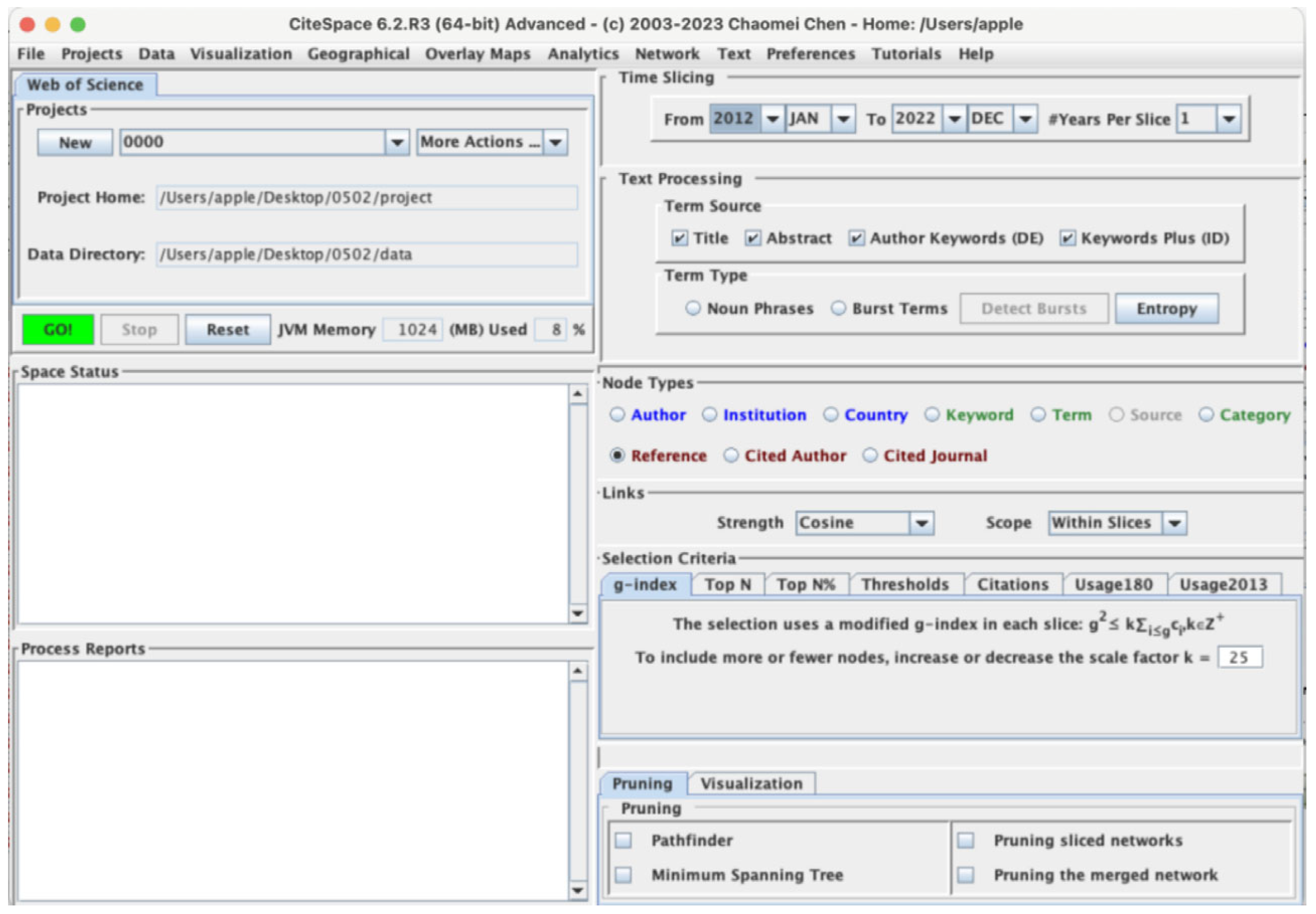
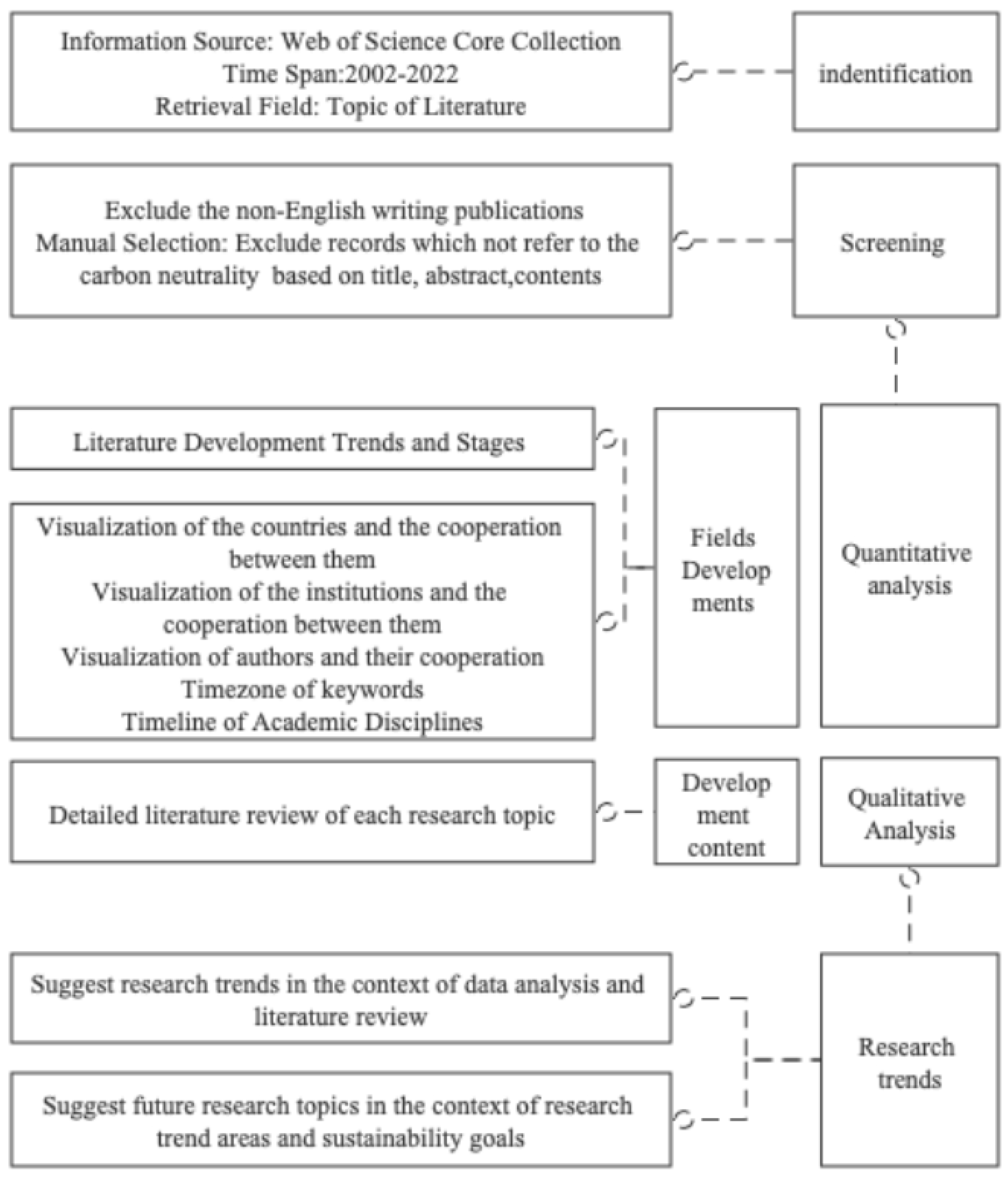
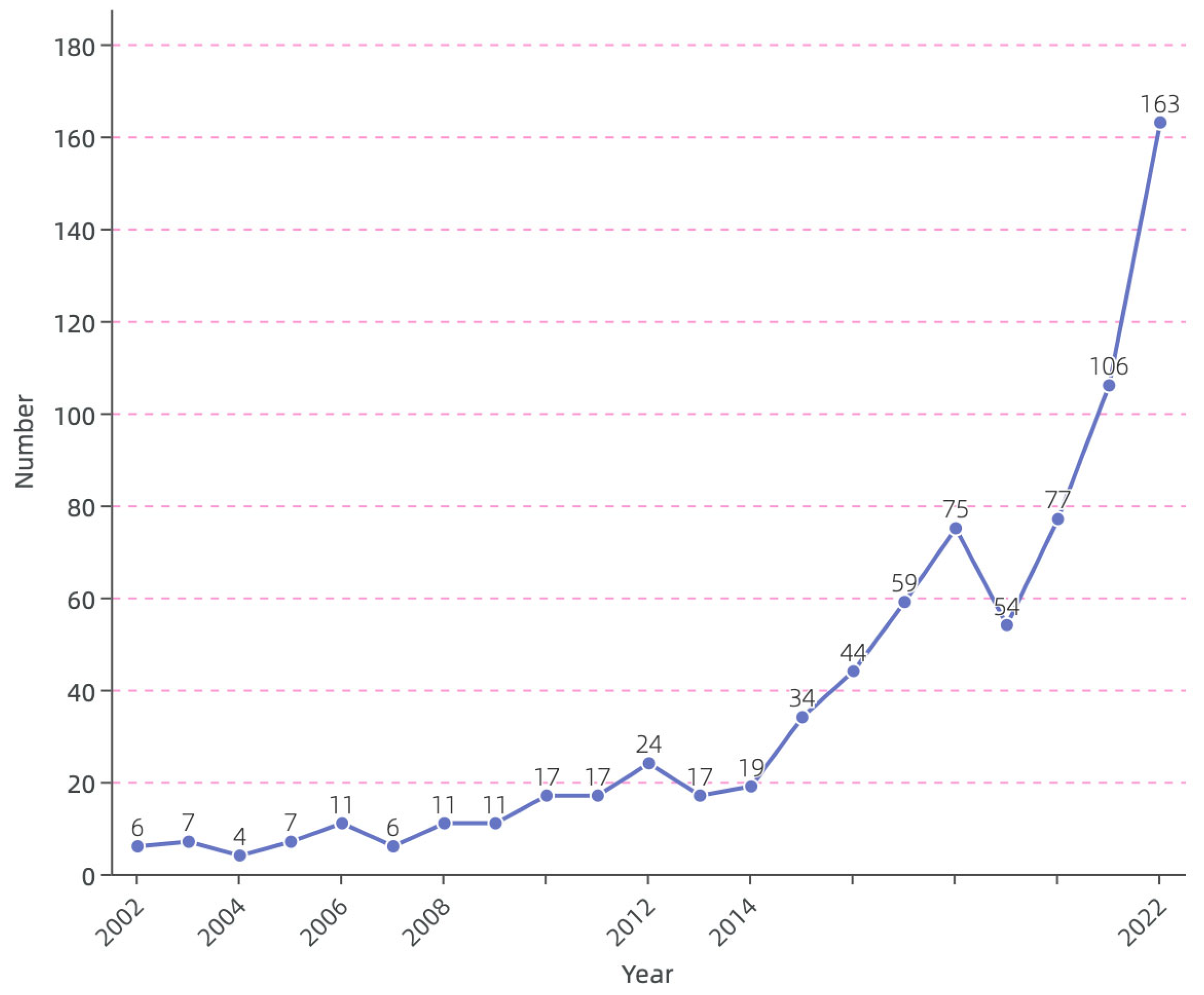
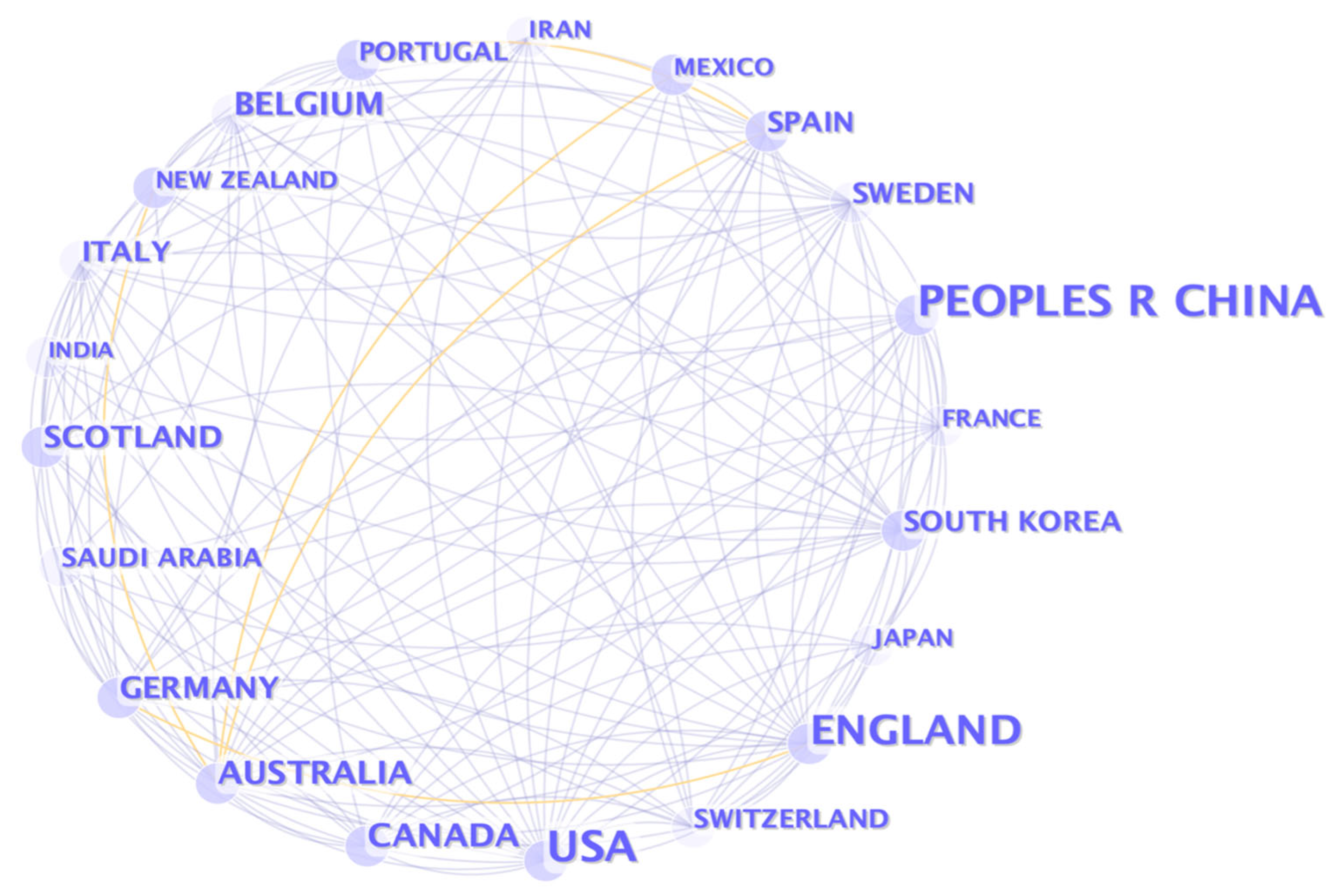

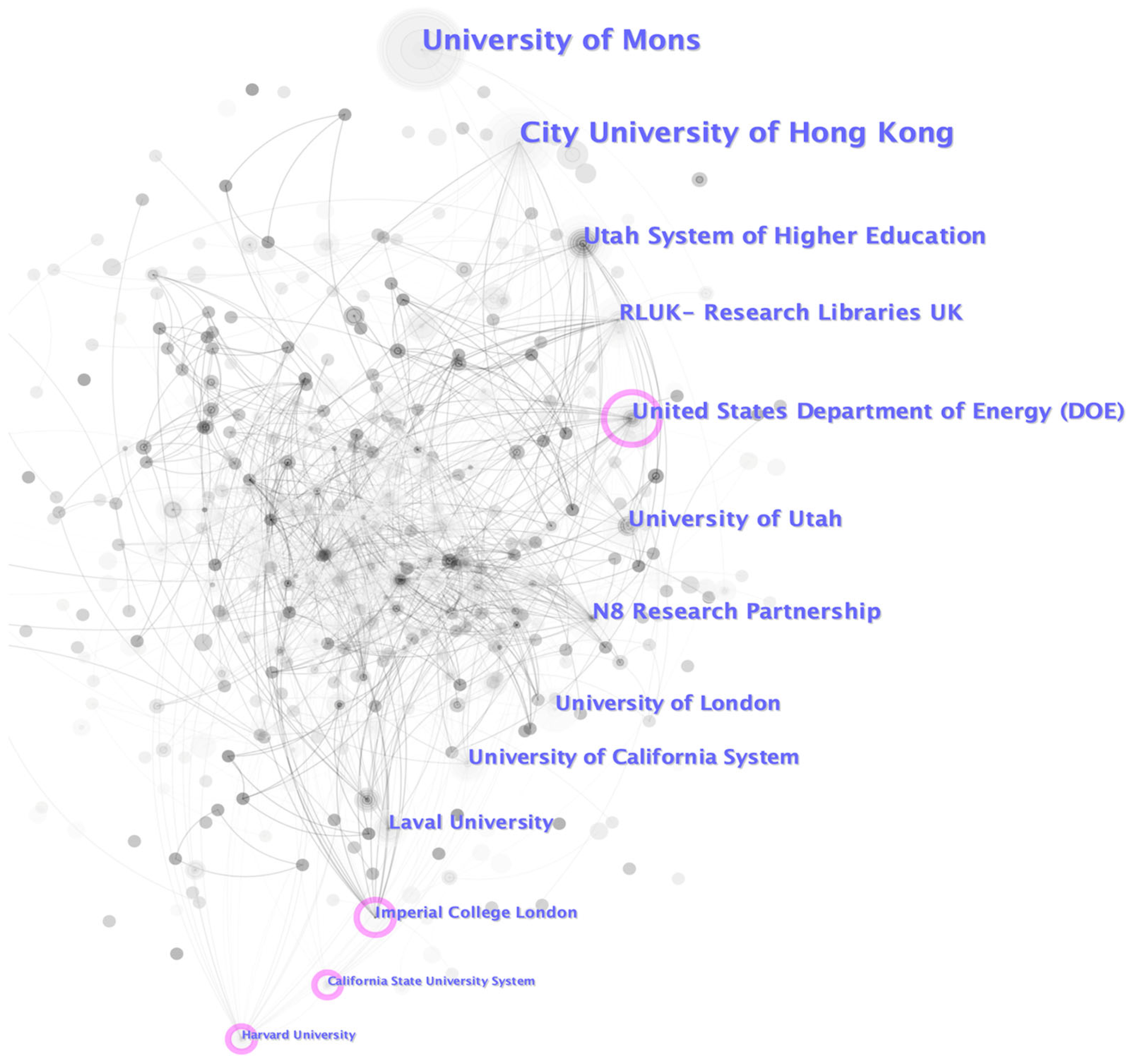


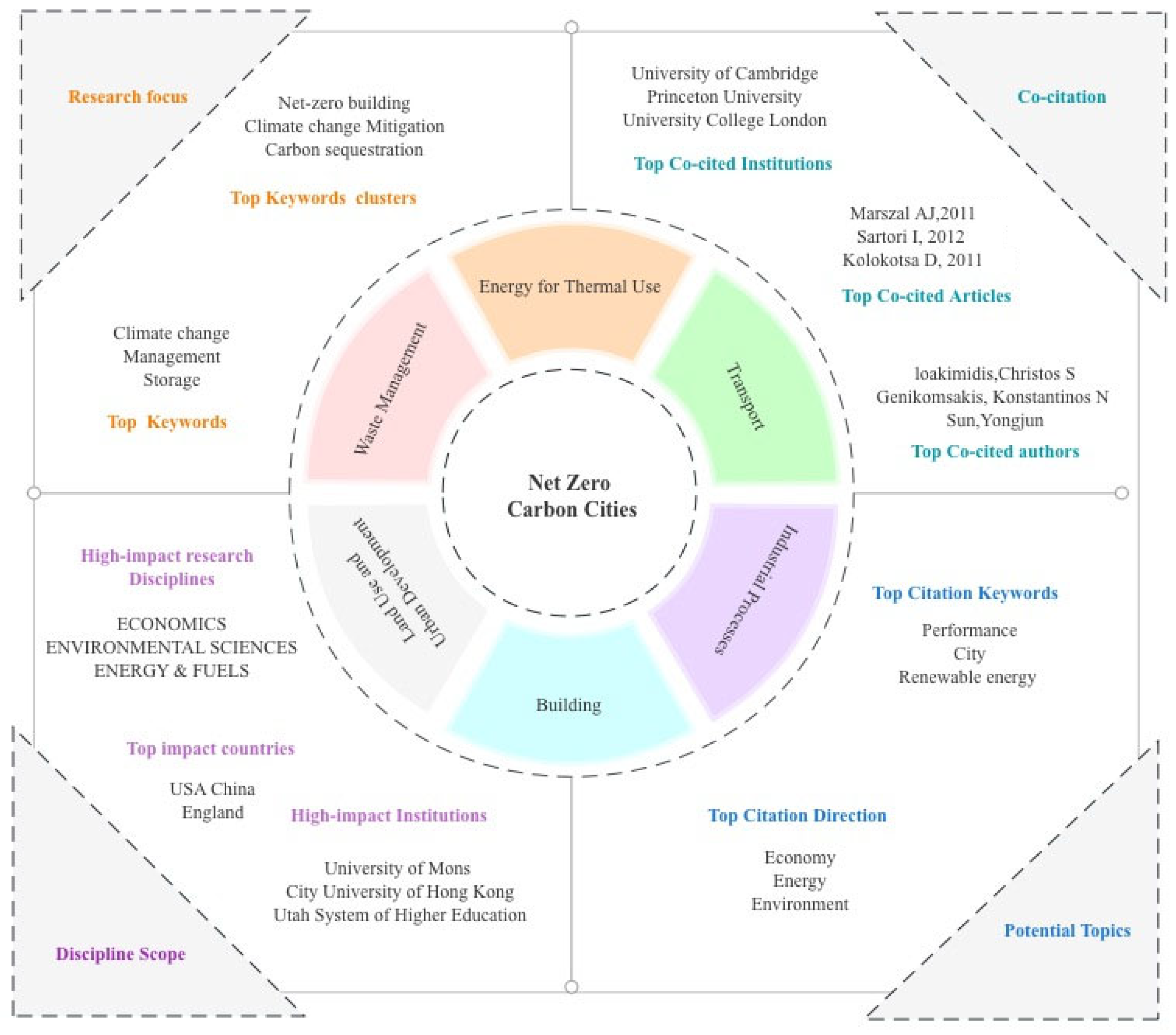
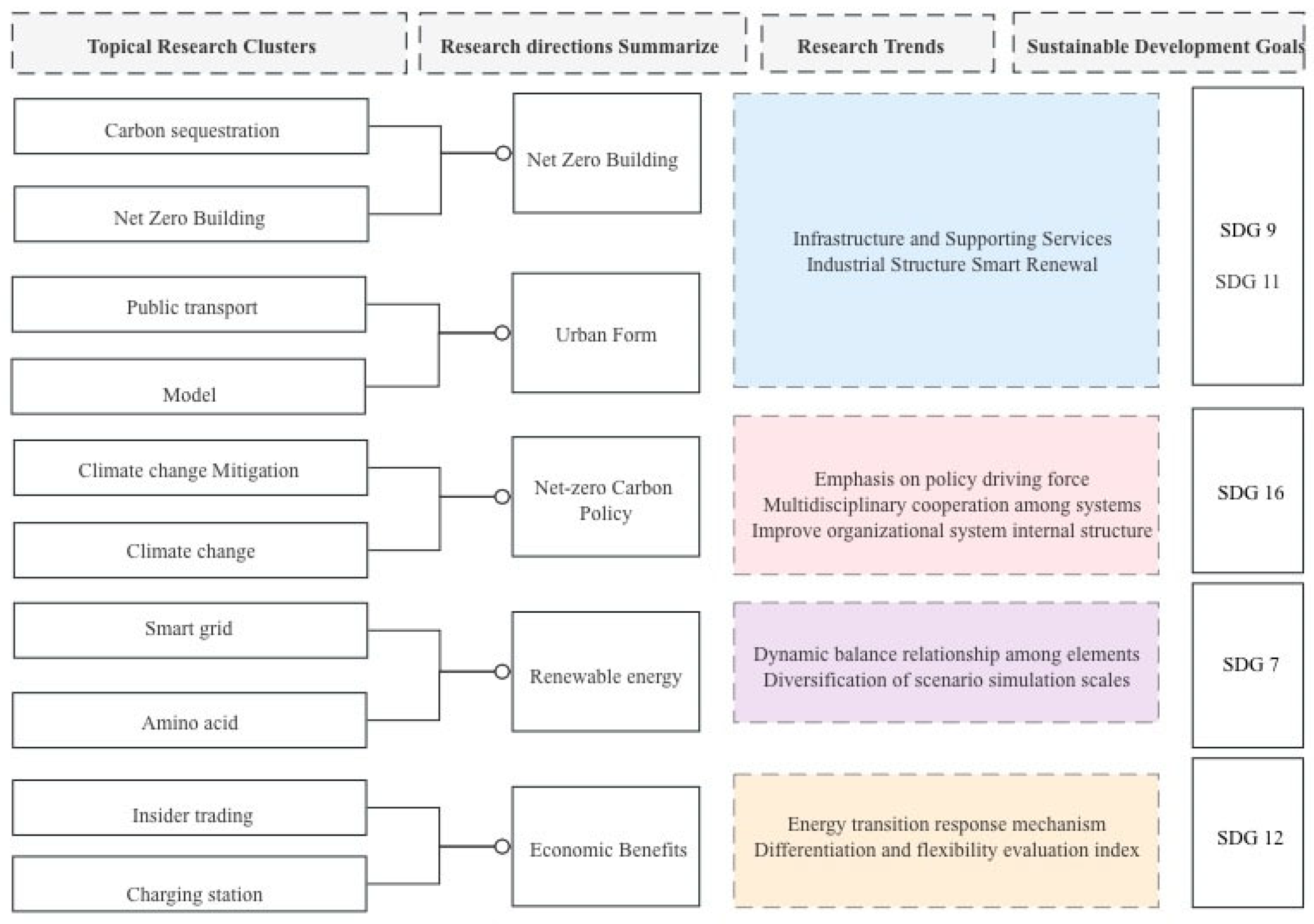
| Countries | Count | Centrality | Year |
|---|---|---|---|
| USA | 212 | 0.25 | 2004 |
| Peoples R China | 163 | 0.11 | 2012 |
| England | 104 | 0.14 | 2013 |
| Canada | 79 | 0.1 | 2001 |
| Belgium | 68 | 0.11 | 2001 |
| Australia and Italy | 55 | 0.1 | 2009 |
| Germany | 47 | 0.07 | 2002 |
| Japan | 45 | 0.07 | 2009 |
| Mexico | 44 | 0.04 | 2000 |
| Spain | 38 | 0.16 | 2009 |
| Institutions | Count | Centrality | Year |
|---|---|---|---|
| University of Mons | 52 | 0.01 | 2015 |
| City University of Hong Kong | 50 | 0.1 | 2008 |
| Utah System of Higher Education | 23 | 0.07 | 2000 |
| University of Utah | 20 | 0.04 | 2000 |
| United States Department of Energy (DOE) | 20 | 0.11 | 2001 |
| N8 Research Partnership | 19 | 0.08 | 2001 |
| University of London | 19 | 0.07 | 2003 |
| University of California System | 16 | 0.04 | 2011 |
| Laval University | 15 | 0.05 | 2010 |
| University College London | 14 | 0.07 | 2006 |
| Authors | Year | Count |
|---|---|---|
| Loakimidis, Christos S | 2015 | 45 |
| Genikomsakis, Konstantinos N | 2015 | 22 |
| Sun, Yongjun | 2015 | 20 |
| Thomas, Dimitrios | 2015 | 14 |
| Koutra, Sesil | 2016 | 12 |
| Bagheri, Ali | 2016 | 11 |
| Huang, Pei | 2018 | 8 |
| Becue, Vincent | 2016 | 8 |
| Deblecker, Olivier | 2016 | 7 |
| Amado, Miguel | 2016 | 6 |
| Authors | References | Citations | Methodology | Theme |
|---|---|---|---|---|
| Marszal AJ, 2011, | Zero Energy Building—A review of definitions and calculation methodologies | 839 | Literature and Case Review | metric of the balance and type of energy |
| Sartori I, 2012, | Net zero energy buildings: A consistent definition framework | 621 | Establishing a research framework | Import/export balance and the load/generation balance. |
| Kolokotsa D, 2011, | A roadmap towards intelligent net zero- and positive-energy buildings | 282 | thermal simulation models | Simulator technology optimization and control |
| Hopfe CJ, 2011, | Uncertainty analysis in building performance simulation for design support | 351 | Building performance simulation (BPS) | building performance |
| Salom J, 2014, | Analysis of load match and grid interaction indicators in net zero energy buildings with simulated and monitored data | 181 | Case Review | load matching (LM)Analysis |
| Marique AF, 2014, | A simplified framework to assess the feasibility of zero-energy at the neighbourhood/community scale | 119 | Establishing an assessment framework | Urban form on energy needs Transportation energy |
| Lu YH, 2015, | Design optimization and optimal control of grid-connected and standalone nearly/net zero energy buildings | 180 | Literature and Case Review | Laws & Regulations Policy Objectives |
| Li DHW, 2013, | Zero energy buildings and sustainable development implications—A review | 410 | Literature and Case Review | deterioration of the environmen And energy resources |
| Zhang S, 2016, | A multi-criterion renewable energy system design optimization for net zero energy buildings under uncertainties | 115 | Renewable Energy System | annual energy balance |
| Deng S, 2014, | How to evaluate performance of net zero energy building—A literatuzre research | 232 | Literature and Case Review | Energy storage, load match and smart grid |
Disclaimer/Publisher’s Note: The statements, opinions and data contained in all publications are solely those of the individual author(s) and contributor(s) and not of MDPI and/or the editor(s). MDPI and/or the editor(s) disclaim responsibility for any injury to people or property resulting from any ideas, methods, instructions or products referred to in the content. |
© 2023 by the authors. Licensee MDPI, Basel, Switzerland. This article is an open access article distributed under the terms and conditions of the Creative Commons Attribution (CC BY) license (https://creativecommons.org/licenses/by/4.0/).
Share and Cite
Duan, Z.; Kim, S. Progress in Research on Net-Zero-Carbon Cities: A Literature Review and Knowledge Framework. Energies 2023, 16, 6279. https://doi.org/10.3390/en16176279
Duan Z, Kim S. Progress in Research on Net-Zero-Carbon Cities: A Literature Review and Knowledge Framework. Energies. 2023; 16(17):6279. https://doi.org/10.3390/en16176279
Chicago/Turabian StyleDuan, Ziyu, and Seiyong Kim. 2023. "Progress in Research on Net-Zero-Carbon Cities: A Literature Review and Knowledge Framework" Energies 16, no. 17: 6279. https://doi.org/10.3390/en16176279




